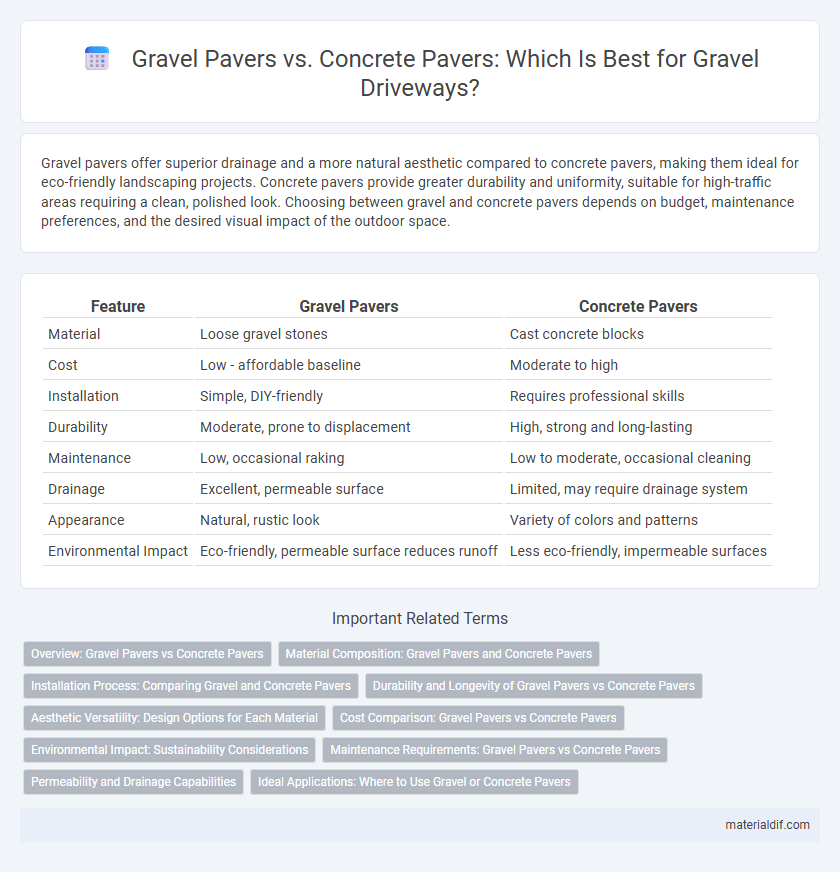Gravel pavers offer superior drainage and a more natural aesthetic compared to concrete pavers, making them ideal for eco-friendly landscaping projects. Concrete pavers provide greater durability and uniformity, suitable for high-traffic areas requiring a clean, polished look. Choosing between gravel and concrete pavers depends on budget, maintenance preferences, and the desired visual impact of the outdoor space.
Table of Comparison
| Feature | Gravel Pavers | Concrete Pavers |
|---|---|---|
| Material | Loose gravel stones | Cast concrete blocks |
| Cost | Low - affordable baseline | Moderate to high |
| Installation | Simple, DIY-friendly | Requires professional skills |
| Durability | Moderate, prone to displacement | High, strong and long-lasting |
| Maintenance | Low, occasional raking | Low to moderate, occasional cleaning |
| Drainage | Excellent, permeable surface | Limited, may require drainage system |
| Appearance | Natural, rustic look | Variety of colors and patterns |
| Environmental Impact | Eco-friendly, permeable surface reduces runoff | Less eco-friendly, impermeable surfaces |
Overview: Gravel Pavers vs Concrete Pavers
Gravel pavers offer excellent drainage and flexibility, making them ideal for permeable surfaces and environmentally friendly landscaping. Concrete pavers provide durability, uniformity, and a wide range of shapes and colors, suitable for high-traffic areas and structured designs. Choosing between gravel and concrete pavers depends on factors like budget, maintenance, aesthetic preferences, and project requirements.
Material Composition: Gravel Pavers and Concrete Pavers
Gravel pavers consist of interlocking grids made from recycled plastic or resin that are filled with gravel, promoting natural drainage and soil stabilization. Concrete pavers are manufactured from a mixture of cement, sand, and aggregates, offering a solid, durable surface with uniform strength and color. The porous structure of gravel pavers contrasts with the impervious nature of concrete pavers, influencing water runoff and environmental impact.
Installation Process: Comparing Gravel and Concrete Pavers
Gravel pavers require minimal site preparation and can be installed quickly with a simple excavation, base layer, and compaction process, making them cost-effective and versatile for various terrains. Concrete pavers demand more extensive groundwork including precise leveling, a stable base with gravel or sand, and joint filling to ensure durability and a smooth surface. While gravel installation offers flexibility and easier repairs, concrete pavers provide a structured, uniform appearance but involve a longer, more labor-intensive installation process.
Durability and Longevity of Gravel Pavers vs Concrete Pavers
Gravel pavers offer exceptional durability due to their flexibility, allowing them to withstand heavy loads and adapt to ground movement without cracking, unlike concrete pavers which are prone to surface fractures over time. The longevity of gravel pavers is enhanced by their permeability, reducing water damage and erosion risks, whereas concrete pavers may deteriorate from freeze-thaw cycles. Maintenance requirements for gravel pavers are generally lower, with infill replenishment extending lifespan, while concrete pavers often need sealing and repairs to maintain structural integrity.
Aesthetic Versatility: Design Options for Each Material
Gravel pavers offer exceptional aesthetic versatility with their natural textures and a wide range of colors and sizes, allowing for organic, rustic, or modern landscape designs. Concrete pavers provide customizable shapes, patterns, and colors, enabling intricate and uniform layouts ideal for contemporary and formal spaces. Both materials support creative design options, but gravel excels in creating fluid, natural-looking environments, while concrete allows for precise, structured aesthetics.
Cost Comparison: Gravel Pavers vs Concrete Pavers
Gravel pavers generally cost between $1 and $3 per square foot, making them a budget-friendly option compared to concrete pavers, which range from $6 to $12 per square foot due to higher material and installation expenses. Gravel installation often involves less labor and fewer materials, reducing upfront costs, while concrete pavers require precise base preparation and skilled labor that increase overall project price. Maintenance costs for gravel pavers remain low with occasional replenishing, whereas concrete pavers might incur higher repair or replacement expenses if damaged.
Environmental Impact: Sustainability Considerations
Gravel pavers offer superior permeability compared to concrete pavers, promoting groundwater recharge and reducing stormwater runoff, which mitigates urban flooding risks. They are typically made from natural, locally sourced materials with lower embodied energy, resulting in a smaller carbon footprint throughout their lifecycle. In contrast, concrete pavers involve energy-intensive manufacturing processes and often contribute to heat island effects due to their non-porous surfaces and higher thermal mass.
Maintenance Requirements: Gravel Pavers vs Concrete Pavers
Gravel pavers require regular raking and occasional replenishment to maintain an even surface and prevent weed growth, with proper edging needed to keep gravel contained. Concrete pavers demand less frequent maintenance but benefit from periodic cleaning, sealant application every few years, and joint sand replacement to inhibit weed growth and shifting. Both surfaces can last decades with appropriate upkeep, but gravel pavers generally entail more hands-on, routine care compared to the lower-maintenance nature of concrete pavers.
Permeability and Drainage Capabilities
Gravel pavers offer superior permeability, allowing water to pass through easily and significantly reducing runoff and pooling compared to concrete pavers. Concrete pavers, while durable and stable, often require additional drainage solutions to manage water effectively due to their low permeability. Choosing gravel pavers enhances natural drainage and supports sustainable water management in landscaping projects.
Ideal Applications: Where to Use Gravel or Concrete Pavers
Gravel pavers excel in permeable surfaces such as driveways, walkways, and garden paths, allowing optimal drainage and preventing water runoff. Concrete pavers are ideal for high-traffic areas like patios, commercial walkways, and garage floors due to their durability and load-bearing capacity. Choosing between gravel and concrete depends on site conditions, desired aesthetics, and maintenance preferences, with gravel suited for eco-friendly, flexible designs and concrete for structured, long-lasting surfaces.
Gravel Pavers vs Concrete Pavers Infographic

 materialdif.com
materialdif.com